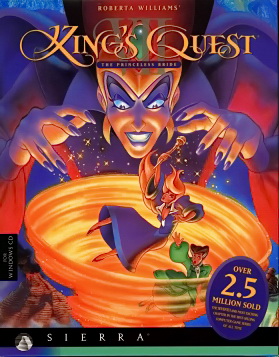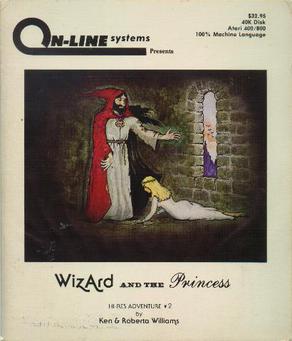Sierra Entertainment, Inc. was an American video game developer and publisher founded in 1979 by Ken and Roberta Williams. The company is known for pioneering the graphic adventure game genre, including the first such game, Mystery House. It is known for its graphical adventure game series King's Quest, Space Quest, Police Quest, Gabriel Knight, Leisure Suit Larry, and Quest for Glory, and as the original publisher of Valve's Half-Life series.

King's Quest is a graphic adventure game series, released between 1980 and 2016 and created by the American software company Sierra Entertainment. It is widely considered a classic series from the golden era of adventure games. Following the success of its first installments, the series was primarily responsible for building the reputation of Sierra. Roberta Williams, co-founder and former co-owner of Sierra, designed all of the King's Quest games until the series' reboot in 2015.

Roberta Lynn Williams is an American video game designer and writer, who co-founded Sierra On-Line with her husband, game developer Ken Williams. In 1980, her first game, Mystery House, became a modest commercial success; it is credited as the first graphic adventure game. She is also known for creating and maintaining the King's Quest series, as well as designing the full motion video game Phantasmagoria in 1995.

Kenneth A. Williams is an American businessman and game programmer who co-founded On-Line Systems together with his wife Roberta Williams. On-Line Systems eventually became Sierra On-Line and was ultimately renamed Sierra Entertainment. The couple were leading figures in the development of graphical adventure games. At its height, Sierra employed nearly 1,000 people prior to its acquisition in 1996.

Jim Walls is an American video game designer. He is notable for having designed the successful Police Quest series of adventure games for Sierra On-Line.

King's Quest: Quest for the Crown is an adventure game developed by Sierra On-Line and published originally for the IBM PCjr in 1984 and later for several other systems between 1984 and 1989. The game was originally titled King's Quest; the subtitle was added to the games box art in the 1987 re-release, but did not appear in the game.

King's Quest II: Romancing the Throne is the second installment in the King's Quest series of graphic adventure games by Sierra On-Line. It was originally released in 1985 for PC DOS/PCjr, and later made available for the Apple II/IIGS, Atari ST, and Amiga. It uses the same AGI game engine as King's Quest I: Quest for the Crown and features King Graham as the player character. The title is a spoof of the 1984 film Romancing the Stone.

King's Quest III: To Heir Is Human is the third installment in the King's Quest series of graphic adventure games developed and released by Sierra On-Line in 1986. The game was originally released for the Apple II and PC DOS, and later ported to several other computer systems. It was the first title game in the series not to feature King Graham as the player character.

King's Quest IV: The Perils of Rosella is a graphic adventure game developed and released by Sierra On-Line for the MS-DOS, Amiga, Apple II, Apple IIGS, and Atari ST computers in 1988. The player takes on the role of Princess Rosella, daughter of King Graham of Daventry and the twin sister of Gwydion/Alexander, who must save her father and a good fairy and destroy an evil witch. Critically acclaimed, it was one of the first PC games to support a sound card.

King's Quest V: Absence Makes the Heart Go Yonder! is a 1990 graphic adventure game by Sierra On-Line. Originally released in November 1990, it featured a significant improvement in graphics. It was also the first King's Quest installment to replace the typing user interface with a point-and-click user interface. The title is a spoof on the proverb "Absence makes the heart grow fonder".

King's Quest VI: Heir Today, Gone Tomorrow is a point-and-click adventure game, first released in 1992 as the sixth installment in the King's Quest series produced by Sierra On-Line. Written by Roberta Williams and Jane Jensen, King's Quest VI is widely recognized as the high point in the series for its landmark 3D graphic introduction movie and professional voice acting. King's Quest VI was programmed in Sierra's Creative Interpreter and was the last King's Quest game to be released on floppy disk. A CD-ROM version of the game was released in 1993, including more character voices, a slightly different opening movie and more detailed artwork and animation.

King's Quest VII: The Princeless Bride is a graphic adventure game developed and published by Sierra On-Line for the MS-DOS, Microsoft Windows and Macintosh computers in 1994. It features high-resolution graphics in a style reminiscent of Disney animated films and is the only King's Quest game with multiple protagonists: Queen Valanice and Princess Rosella, who are both spirited away to the realm of Eldritch, and Rosella is transformed into a troll. They must find a way to return Rosella to normal and find her true love, get rid of a powerful evil force threatening this realm, and get back to their kingdom Daventry.

Roberta Williams' Mixed-Up Mother Goose is a computer game first released by Sierra On-Line in 1987. It is, in essence, an edutainment title, directed specifically at young gamers, as well as an adventure game. It was the first multimedia game released on CD-ROM in 1991. A second game in the series, Mixed-Up Fairy Tales, was released in 1991.

The Silver Lining (TSL) is an episodic video fangame based on the King's Quest series, which was developed and released in free download format by Phoenix Online Studios for Microsoft Windows starting on July 18, 2010. While five chapters were planned, the most recent release, Episode 4: 'Tis in My Memory Locked. And You Yourself Shall Hold The Key Of It, was released on November 8, 2011.
The King's Quest Companion is a book by Peter Spear that serves as both hint book/walkthrough and contained complete novelization of each of the games in the King's Quest series by the original Sierra On-Line company. The first three editions were published by Silicon Valley Books, and fourth edition by Osborne/McGraw-Hill. The novelization for KQ6 was written by a guest writer, Eluki Bes Shahar.

Wizard and the Princess is a graphic adventure game written for the Apple II and published in 1980 by On-Line Systems. It was the second title released in the Hi-Res Adventures series after Mystery House. While Mystery House used monochrome drawings, Wizard and the Princess added color. Ports for the Atari 8-bit family and Commodore 64 were released in 1982 and 1984 respectively. The 1982 self-booting version for IBM PC compatibles was renamed Adventure in Serenia.
An adventure game is a video game genre in which the player assumes the role of a protagonist in an interactive story, driven by exploration and/or puzzle-solving. The genre's focus on story allows it to draw heavily from other narrative-based media, such as literature and film, encompassing a wide variety of genres. Most adventure games are designed for a single player, since the emphasis on story and character makes multiplayer design difficult. Colossal Cave Adventure is identified by Rick Adams as the first such adventure game, first released in 1976, while other notable adventure game series include Zork, King's Quest, Monkey Island, Syberia, and Myst.
King's Quest II: Romancing the Stones is a fangame reimagining/retelling of Sierra Entertainment's King's Quest II: Romancing the Throne by AGD Interactive produced through a fan license by Sierra Entertainment. It was followed up by King's Quest III: To Heir Is Human. In 2009, the version 3.0 Enhanced Edition was released, with improved graphics and full-speech narration. The game earned the AGS award for best music and game in 2002.
There have been several King's Quest fangames both original and retellings/remakes of the original games that have been released by various developers.

King's Quest is an episodic video game series developed by The Odd Gentlemen and published by Activision under the Sierra Entertainment brand name for Microsoft Windows, PlayStation 3, PlayStation 4, Xbox 360 and Xbox One. It is a new re-imagining of the long-running King's Quest series. While it is an adventure game like the previous games in the series, the interface is not fully point-and-click.















